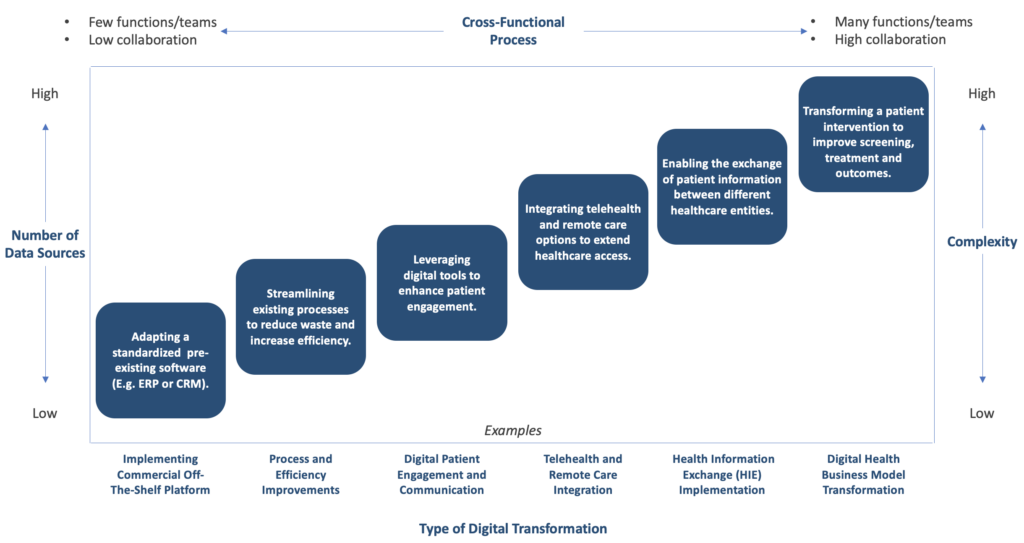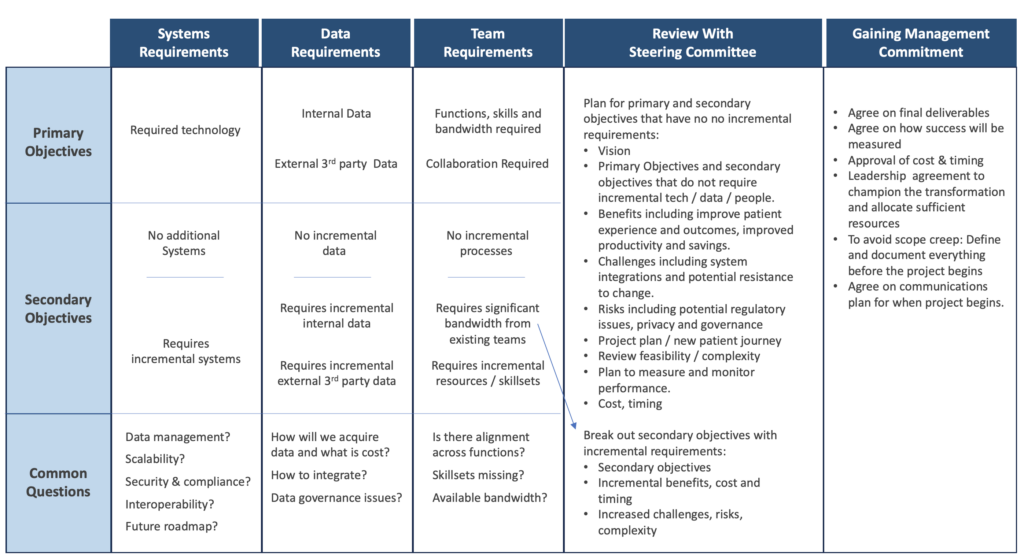5 Things to Get Right When Planning a Digital Transformation in Healthcare

The healthcare landscape is riddled with inefficiencies, from cumbersome administrative processes to diagnostic delays that can impact patient outcomes. However, at the intersection of real-world data, artificial intelligence (AI), and cutting-edge technology lies a prescription for reshaping healthcare as we know it – including improved screening/diagnostics, predictive analytics, personalized medicine, and remote patient monitoring/treatment. Healthcare is ripe for digital transformation.
However, more than half of digital transformations do not achieve their objectives. Often, this is due to embarking on projects that are overly broad, or which had missteps in planning, including not accounting for key details and misalignment across the organization.
Here are five things to get right to have a successful digital transformation in healthcare:
1. Set the right goals.
2. Get the team and process right.
3. Get the data right.
4. Get the technology right.
5. Get management’s commitment.
Setting the right goals
When setting goals for a transformation it is important to balance ambition and feasibility. Ensure that the transformation’s goals are aligned with the organization’s overall mission and goals. Get together with the Executive Sponsor / Steering Committee to gather their desired outcomes. Strive to set patient-centric goals that improve their experience and outcomes. These improvements should drive the business outcomes your organization wants.
Agree on what success is and how it will be measured – with clear and specific KPIs. Before committing to the project, the Executive Sponsor should understand the complexity of the initiative.
The two biggest drivers of complexity in healthcare are the data sources required (number of sources and type of data) and the level of cross-function and cross-organization collaboration that is needed. Below is an illustration of the complexity of sample healthcare transformations.

Getting the team and process right
Building the right team for a healthcare digital transformation involves a thoughtful approach to roles, skills, and collaboration. It is best practice to establish a project management office and an initiative leader to oversee the planning, implementation, and monitoring/optimization of the transformation. Ideally, this leader should have experience in planning and implementing transformational projects.
The Initiative leader should meet with executive sponsors early in the process to understand their prioritized goals and thoughts on success and prioritization. Agree on meeting cadence and when to review a transformation plan with success criteria, costs, and timeline. Executive sponsors should reach out to cross-functional teams to inform them of the transformation and request their support.
You will need to engage representatives from different departments, often including functions such as IT, clinical, data science, administrative, patient engagement, and data governance experts to ensure a holistic perspective. In an initiative like this, there will be group meetings, but it is imperative that the initiative leader also has one-on-ones with each function to get their input, capture requirements or codependencies, and assess the skills and competencies. Only having cross-functional group meetings will lead to missing key details. Work with your cross-functional partners to illustrate the patient experience, and map out the process including roles, deliverables, timelines, and dependencies. These illustrations should be easy to understand and avoid unnecessary jargon.
Create contingency plans for potential bottlenecks or delays related to interdependent tasks. I also recommend adopting agile project management methodologies to facilitate flexibility, adaptability, and continuous improvement.
Getting the data right
Start by finding the specific data needed for your primary aims and for your secondary goals. Then assess what you have internally and identify what would have to be collected from patients and/or sourced externally.
Common external data sources may include:
- EHR data
- Claims data
- Pharmacy data
- Lab data
- Vaccine data
- Wearable device data
When planning the project, show how the data will be sourced and any costs that might be incurred. If it’s patient-reported, ensure to include a detailed process for capturing their consent as well as the data. If you are planning to buy health data from a third-party source, make sure that your specific use case aligns with the data supplier’s data governance policies.
As appropriate, you should include standardizing and normalizing data across internal and external sources to ensure consistency. If your data sources are updated on different schedules, make sure that it works for your use cases.
Depending on the transformation you may need to develop a strategy for mapping and matching patient identities across different data sources. In this case, consider advanced matching algorithms to accurately link patient records and avoid duplicates. If the success of your transformation depends on an external partner, be specific about your needs up front and run feasibility tests to ensure that they can provide what you need, in the right format, when you need it.
When you have a first draft of your data plan, set up a robust data governance framework to define policies, roles, and responsibilities for data management and review with the right persons in your organization. Address data quality, security, privacy, and compliance considerations, aligning with relevant regulations such as HIPAA compliance.
By following a systematic process and avoiding common mistakes, you can develop a robust data plan that sets the foundation for a successful healthcare digital transformation.
Getting the technology right
With an understanding of goals, use cases, and KPIs, the project leader can begin engaging IT to discuss technology requirements. This can be done in parallel with setting up data requirements.
As with data, I recommend naming the technology needed to achieve the primary goals and what is needed to achieve the secondary objectives. It is ideal if all desired deliverables could be delivered with the same technology, but if not, this should be shared with the executive team.
Take inventory of your internal technologies to assess if you have the in-house technology to implement the transformation, but if not, any new technologies should be compatible and scalable to accommodate your organization’s growth and evolving needs. If you need to bring on new technology, you will want to evaluate based on criteria such as data storage and management that complies with your data security and governance guidelines, has a strong performance and reliability track record, and is user-friendly. Also, understand the extent to which the platform can be customized to meet your unique needs. Ensure that it can supply the analytics and reporting that you need, including the KPIs for the initiative. Before deciding, I recommend speaking with current customers and understanding the support and maintenance plan. Make sure that you understand the total cost of ownership to ensure that you are budgeting appropriately.
Once you prepare a plan with the right goals, team, data, and technology – bring it together with a budget and timeline to meet your primary goals as well as any secondary goals that can be achieved without incremental costs.
Below is a modifiable template that I’ve used to develop the transition plans I use in my practice. I recommend that you share the populated template with the cross-functional team members that you met with and get their sign-off before reviewing it with the Executive Sponsor / Steering Committee.

Getting management‘s commitment
Now it’s time to bring everything together and gain organizational commitment. I recommend scheduling an in-person meeting with the Executive Sponsor / Steering Committee and begin by reviewing the current state, the vision, and the transformation needed to achieve that vision. This sets up reviewing the primary goals and secondary goals and the data, technology, and team needed to implement. Also review the costs, timing, and risks for both sets of goals.
If new technology is required, you will want to be prepared to discuss interoperability with existing systems’ scalability and adaptability. Lastly, review the plan for monitoring and measuring the success of the transformation program.
If the management team is prepared to move forward, you should also include the change management plan and review the support that leadership would need to provide.
Conclusion: Charting the course for a transformed healthcare future
Healthcare is facing challenges and keeping the status quo is not an option. Transformation is needed, and success will be predicated on the right combination of data, technology, and teamwork. This starts with a well-thought-out plan. While not an easy road, the reward is in better patient experiences and outcomes. This article should help you approach it with more confidence and clarity.
Find healthcare digital transformation Experts now.
Let’s TalkMeet the Author

Tom Quinn is an Expert on the Catalant platform with 25 years of experience in Marketing, Analytics, Digital Transformation and Commercial Strategy. Tom held leadership roles at Circana (formerly IRI) and Razorfish, is a former CEO of Real Time Content and is now an independent consultant. He has worked with Health and Life Science leaders such as AstraZeneca, CVS Health, Novartis, and Pfizer. Tom has an MBA from the Mendoza College of Business at the University of Notre Dame.
Want to work directly with Tom Quinn? Contact us to learn how.











